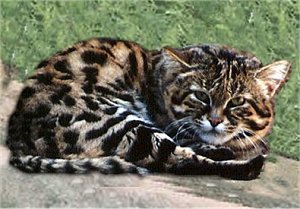The black-footed cat (Felis nigrippus)

Africa's smallest feline predator is also one of its fiercest.
The black-footed cat may not be particularly rare, but even people who live in the same area as one of these tiny cats may never see one. For a start there is not a lot of cat to see. A muscular male might weigh in at 2.5 kg (5.5 pounds) but a female might be as little as 1.5 kg, making her the smallest of all the wild cats. Secondly black-footed cats are nocturnal, and spend the day squeezed under tiny rock ledges or in hollowed-out termite mounds (which together with its natural ferocity has earned it the native name of 'anthill tiger').
Secondly, these cats have tawny spotted coats which allows them to blend perfectly into the open grassy savanna which is their natural habitat. Many black-footed cats live in Botswana and Namibia, and have adapted well to their arid environment on the edge of the Kalahari and Namib deserts. They have long hairs around the pads on their feet which provide protection from hot sandy ground, and they need to drink little or no water to survive, getting the moisture that their bodies need from their prey - or in some cases from eating grass. In fact, a problem with breeding black-footed cats in captivity is that they die of respiratory failure in high humidity, and need taking indoors if the temperature drops below 40 Fahrenheit. Unlike most spotted cats, black-footed cats have pink skins rather than heat-absorbing black - apart from the pads of their feet, which are black, and what gives the cats their name.
As a result of this there are only a few dozen black-footed cats in captivity anywhere in the world. They are hard to raise, and most die from kidney failure, though no-one is sure what brings this on. Though small, black-footed cats are not cute, and they certainly are not suitable pet material, even if the health issues are resolved. Some of these ferocious little predators have been known to kill sheep by hanging on to their throats until they have bitten through the jugular. They will occasionally take up residence in holes used by the indigenous spring hares, and are quite capable of killing the occupants, which are considerably bigger than they are.
Insects, spiders and small birds make up much of their natural prey, together with a large number of small rodents. Black-footed cats are extremely energetic and burn through their calories at an amazing rate. One male was recorded as eating a third of his own body mass in a single night in an attempt to keep up with his metabolism. One sixth of body weight is quite normal, as is travelling over 8km in a single night whilst searching for prey. Not surprisingly, given its energy requirements, the black-footed cat is an 'opportunistic hunter' - basically it will try to eat anything with two, four, six or eight legs. The local people assure visitors that black-footed cats have been known to attack giraffes, and they are certainly quite capable of taking down white-quilled bustards on the wing, though the wingspan of the bird is generally at least equal to the 50cm body-length of an adult black-footed cat.
Given its ability to almost literally bite off more than it can chew, it is no surprise that these little cats are expert at hiding kills that they cannot consume immediately, and returning to their meal repeatedly over several days.
For a small cat, the black-footed variety has a big voice. Because they usually live solitary lives, they have to make their mating calls go a long way, and their echoing calls can be heard for a surprising distance across the African savanna at night. Father hangs around for as long as it takes to finish mating, and leaves the female in charge of the kittens. There are usually 2-3 of these, which are born 65 days later. The kittens take about eighteen months to reach maturity, though they are out of their nest and eating solid food within two months. A group of kittens will instinctively split up at the first sign of danger, with the kittens hiding in total immobility until the mother announces with a low meow that all is well.
Perfectly adapted to their habitat, the black-footed cat is mainly in danger from humans - not that humans have anything against the black footed cat, but its natural appetite leads it into traps designed for other animals such as jackals. When left to live out its life in peace, a black-footed cat appears to live for about 10-12 years, though so shy is this mysterious little animal that even this is not certain.

